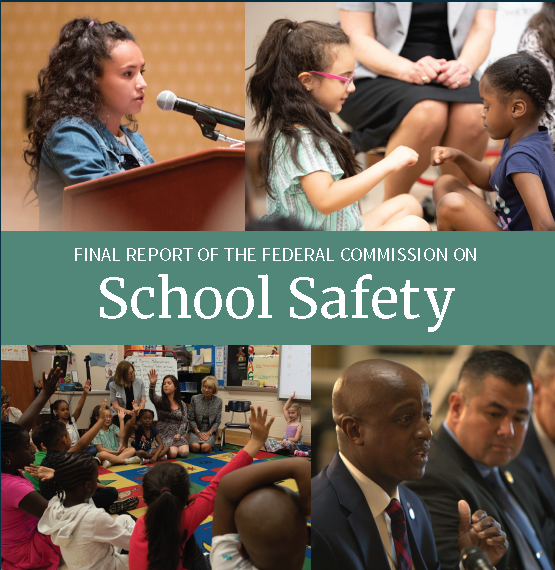Posted on December 20, 2018.
Radios or phones that do not receive signals inside school buildings cited as a serious gap.
The Federal Commission on School Safety, an undertaking of the U.S. Department of Education, Department of Homeland Security, Department of Health and Human Services, and the Department of Justice, issued a 180 page report outlining recommendations that address multiple aspects of school safety.
"Each of us has a role to play in improving the safety of our students and the security of our schools. Only by working together can we help prevent future tragedies and, when those incidents do occur, mitigate their effects and continue to learn from them," states the report. p 2

Download the Full Report Here
- Recommendation: DHS, in partnership with the U.S. Departments of Education and Justice, should explore legislative, regulatory, or procedural modifications to existing grant programs to enable more grant funding or related resources to be available for enhancing school security operations and physical infrastructure. As part of this, DHS should explore designating a portion of Homeland Security Grants for school security activities, and premise the use of those funds on activities that accomplish enhancements recommended in DHS guidance or standards. p126
- Communication Systems and Protocols: The ability to communicate quickly and effectively often is central to a successful response to an active shooter incident. This includes the ability of school staff or students to quickly inform law enforcement of an active shooter situation, thus initiating the law enforcement response; the ability to quickly alert staff, students, and other members of the community of an ongoing active shooter situation in order to initiate a lock down, evacuation, or other appropriate action; and the ability for law enforcement to communicate among themselves and with the school as necessary during a response. p 144-145
Unfortunately, as Max Schachter, CEO and Founder of Safe Schools for Alex, noted during his testimony to the Commission, there are “communication-related problems that impede law enforcement during all tragedies, including [the Parkland school shooting].” These may include outdated or insufficient communications equipment (e.g., radios or phones that do not receive signals inside school buildings), lack of training on existing communications equipment or protocols, and a lack of interoperability between the communications equipment possessed by first responder organizations and the school. p 144-145
Schools should consider establishing, maintaining, testing, and training on communication technology and protocols (e.g., emergency alerts, mass notifications, intercom announcements) that can alert both staff and students, as well as parents and the broader local community, of an active shooter situation. Within schools, it is best if alerts are both audible and visual, and can be seen and heard throughout the entire school grounds.
Finally, schools should consider working with local law enforcement to test, drill, and exercise the communications equipment first responders will be using during a response to ensure its adequacy. Often, the hardened physical construction of school buildings can make radio or phone communication within the school buildings difficult. Communications equipment that does not properly function within the school will be of extremely limited value during a response. Additionally, as Max Schachter pointed out in his testimony, interoperability of communications equipment, which was a problem during the 9/11 attacks, remains a problem today. For instance, during the response to the Parkland shooting, a lack of interoperable equipment forced law enforcement to resort to hand signals. States and localities can take action to help address these concerns.
For example, during the August 28 Commission listening session, Georgia State Representative Rick Jasperse noted how the Georgia legislature provided funding for schools that many are using to acquire “better communication within the school building so when law enforcement rides up, the radios work in the building.” p 145
- Recommendation for States and Local Communities: Effective communication systems and rapid dissemination of information can save lives during an incident or event. Schools should establish and maintain effective communications systems (e.g., one-way intercoms or two-way radios) to rapidly provide alerts, warnings, or other key information during an incident. Schools should test their communications equipment and methods during training and exercises. States and localities should also undertake efforts to ensure interoperability of local law enforcement and school communications equipment. p 151


